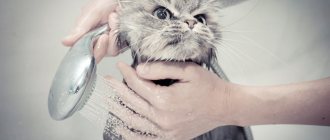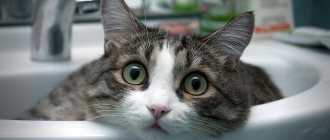Is it possible to bathe a kitten
Many happy owners of kittens have a reasonable question whether they can be bathed and whether this procedure will harm the babies. In the first weeks of life, there is no point in bathing, since every mother cat diligently monitors the cleanliness of her babies and often licks their fur. In addition, for very small kittens, temperature changes during the bathing procedure can be unsafe for health.
The sooner you start accustoming your kitten to water procedures, the easier it will be for him to tolerate them as an adult.
When the kitten grows up a little, he already looks after himself, so he is able to keep himself clean. But, nevertheless, most kitten owners, including professional breeders, agree that kittens still need to be bathed. But you shouldn’t be overzealous with water procedures.
For your information! The optimal age to start active bathing is the period when the baby's baby teeth change.
At what age should you bathe a kitten?
At what age can kittens be treated for fleas?
There is no clear and precise answer to the question of at what age can a kitten be washed. Most pet owners believe that a kitten should begin to accustom itself to water at 2-2.5 months, some say 3-4 months.
In addition, sometimes unforeseen situations happen when swimming cannot be avoided:
- the kitten got very dirty or something accidentally spilled on it;
- a couple of days after its acquisition (he will need this time to adapt to the new place);
- if it was picked up on the street, then it should be washed immediately, and age in this case does not play a special role;
- if we are talking about purebred kittens who take part in various exhibitions from early childhood, then a few days before this event it is customary to bathe the babies, moreover, using various cosmetics that can give the coat a more attractive shiny appearance;
- during molting, thanks to bathing, dying and falling out hairs will be removed without clogging the apartment;
- if the baby sloppily went to the toilet or has parasites.
A kitten picked up on the street should be bathed as soon as it is brought into the house, and it is imperative to use remedies against external parasites (fleas, ticks, lice eaters), as well as against possible skin diseases.
A kitten picked up on the street should be washed immediately, regardless of its age.
But you shouldn’t be overzealous when it comes to bathing, either, since too frequent water procedures, and even with the use of various shampoos, negatively affect the protective fat layer on the kitten’s skin. Therefore, it will be quite enough if you bathe it at least several times a year. If your furry pet has long white fur, then, of course, the procedure will need to be carried out much more often.
Of course, if a cat is a lover of water treatments, and the sound of water flowing in the bathroom makes him have an irrepressible desire to bathe, then this can be done often. But it should be remembered that in this case you will need to be more careful in choosing detergents; they should not unnecessarily dry out the baby’s skin.
How can you wash a kitten, the most common types of shampoos
Cats should not be washed with human shampoo. Products for cats and people differ in their acid-base balance. And for your favorite cat in the pet store you need to find shampoo based on the age and breed of the animal. Those intended for the smallest are marked “For kittens.”
All bathing products can be divided into:
- caregivers;
- medicinal.
The latter contain insecticidal substances that help get rid of parasites - fleas, lice, and the former are classified into products that take into account:
- type of cat's fur (long or short);
- color (there are special products for white and black cats);
- breed. Each breed has its own shampoo, which is usually used by owners of show animals.
In addition to traditional detergents, you can find spray or dry shampoos on sale. The latter are best used if, despite all efforts, you cannot accustom the kitten to bathing. After spraying dry soap onto the animal's fur, after a couple of minutes it is enough to remove it with a comb.
For long-haired cats - Siberian, Angora, Persian, manufacturers have developed special formulations that eliminate the formation of tangles. After bathing, the cat needs to comb its fur. Shampoo-conditioners will also help to preserve the beauty, making the cat’s coat soft and silky after washing.
Bathing can turn into a favorite procedure if done correctly the first time. Warm water at a comfortable temperature, a gentle word of encouragement, a couple of tidbits as approval, and the cat will be the first to rush to the bathroom, hearing the sound of pouring water and the call: “Let's go for a swim!”
Bathing a kitten for the first time
Those owners who are going through this procedure for the first time are worried and worried about how to wash the kitten for the first time. The most important condition for a successful bath is that you need to carefully prepare for such an important event in the baby’s life so that the procedure goes quickly and is not too tiring for the animal.
Hypoallergenic cat food: which one is better?
Before washing you need to prepare everything that will be needed in the process; it will be much easier if everything is at hand. It is better to carry out the procedure itself in a bathtub, sink or in a bowl, which is filled with 6-10 cm of water (depending on the size of the baby). The water should be warm, not hotter than 38 °C.
Note! The bathing procedure should be carried out when the baby is not hungry, is absolutely healthy, has already had enough fun and is in a good mood.
It is better to bathe your furry pet a couple of hours after eating, when he has had enough of playing and is in a relaxed state.
It’s great if someone assists the baby during the bathing procedure: this way one person can distract his attention, and the second can quickly do all the necessary manipulations.
The room where the kitten will bathe should be warm and under no circumstances should there be drafts.
The sequence of actions when bathing a kitten is approximately as follows:
- If the owner is afraid that water may get into the kitten’s ears during bathing, then it is better to cover them with tampons soaked in vegetable oil. This is not necessary if you are confident in the accuracy of the actions.
- The kitten, carefully held by the withers, is placed in a container of water, where he either stands or sits - it all depends on how he feels more comfortable. It is important that it does not slip during the bathing procedure, so it would be good to lay a towel or mat on the bottom, this will make it much more comfortable for the baby.
- Carefully wet the animal's fur from the neck to the tail and, holding it, apply shampoo, but very carefully so as not to get into the eyes, ears and mouth.
- Using gentle movements, the shampoo is carefully rubbed into the fur, this way not only it, but also the animal’s skin will be washed.
- The applied shampoo is washed off carefully but thoroughly. You shouldn’t get your baby’s head wet; just at the end of bathing, you can gently wipe the baby’s face and eyes with a damp hand.
- After completing the procedure, the animal is wrapped in a towel that can absorb water well. His head should be left outside.
- After carrying out water procedures, do not forget about the need to carry out other important measures: the baby must clean his ears, trim his claws if necessary, and wipe his eyes.
While bathing, you need to talk to your pet gently and calmly, so as not to scare him with a loud and sharp cry. After the event is over, you can pamper your baby with his favorite treat.
Drying a kitten
The kitten wrapped in a towel is held in your arms and periodically blotted with a towel for 10-15 minutes. After this time, the kitten’s fur will have dried out enough, and it can be released onto a litter or sofa.
At the end of bathing, you need to clean the cat’s ears, wipe his eyes and trim his claws.
You should not actively dry the animal’s fur with a towel, as it can be damaged.
How to dry
After bathing, the pet is dried with a terry towel and wrapped in a soft cloth. You should not rub the fur vigorously - it will become very tangled.
Then the kitten is released. He begins to actively lick himself and dries his coat on his own. The rough tongue combs the hairs and evenly distributes protective lubricant over them.
If your baby trembles for more than 5 minutes after bathing, you should use a hairdryer. The same applies to long-haired breeds. However, the baby must first be introduced to this device, otherwise he will be scared. The air flow should be warm, but not hot. During the drying process, the fur is combed in the direction of hair growth.
Important. For 12 hours, the kitten should be in a warm room without drafts and not go outside.
If you bathe a kitten correctly, it will not be afraid of water. It is important to teach your baby hygiene from childhood and use suitable detergents - then the procedure will not cause much trouble.
Features of washing hairless cats
Cat litter: which options are best to choose
How to bathe a Sphynx kitten and how often should it be done? The fact is that hairless cats get dirty faster than their brothers in fur coats, so they will need bathing much more often. In addition, hairless breeds of cats sweat much more, and a lot of different debris can accumulate in their folds in the form of leftover food, litter, and lint.
It’s difficult to say for sure how many times a month to bathe a hairless pet. On average, this happens every 2-4 weeks, it all depends on its color and degree of contamination.
Bathing hairless cats has its own distinctive features
Typically, the following signs are a signal for water treatments in hairless cats:
- an unpleasant odor began to emanate from the pet;
- the baby's skin has become sticky and oily;
- Dirt is clearly visible in the folds of the skin.
But washing a bald baby too often will also not do him any good, since the special lubricant produced by the sebaceous glands is washed off, and the kitten is thus deprived of natural protection against various pathogens.
Important! Hairless cats are prone to rapid hypothermia after water treatments.
In general, the procedure for the first bath of an ordinary kitten and a small sphinx is not very different. The only difference is that you need to wash a hairless baby with a special soft sponge, carefully treating the fold areas, and use a special shampoo for cats without hair.
At the end of the water procedures, the kitten’s face, ears and back of the head are wiped with special sanitary napkins.
Water procedures: economy option
It happens that there is no need to bathe the whole pet, but only certain parts of the body need to be tidied up. Here's how to do it:
- ears are cleaned with cotton pads and a special ear lotion;
- the muzzle - with cotton pads, and the chin - with zoo shampoo;
- butt - with wet wipes;
- nose - with a paper napkin;
- paws (after using the toilet or walking) - with water in the washbasin;
- eyes - with wet disks, and if they are watery - with cotton wool dipped in freshly brewed tea.
Bathing Scottish and British kittens
In this case, the bathing procedure also has its own specific, albeit minor, differences.
The bathing process should take place in an organized manner, without fuss and loud shouts. Before you bathe your kitten, you need to prepare all the necessary items and a large, moisture-absorbing towel.
Fold kittens are bathed approximately once a month. A specific feature of this procedure is that special shampoos for long-haired breeds, which are used when bathing Scots, are applied to the animal not with massaging, but with stroking movements, and then thoroughly washed off.
And one more small feature of bathing these breeds of kittens - after taking a bath, they should be dried with a hairdryer. Of course, the animal will not experience much delight during this procedure, but it’s better than drying out for several hours and being exposed to the danger of hypothermia and getting sick all this time.
By the way, while drying with a hairdryer, it is also advisable to comb the baby’s thick fur.
Should I bathe after vaccination and castration?
If the kitten has been vaccinated, or has undergone castration or some other operation, then it would be correct to bathe it no earlier than a couple of weeks after that.
Is it possible to wash a kitten, at what age will it not harm it - questions that concern many cat owners who have had a long-awaited or unexpected addition in the form of a newborn or selected baby. Many professional breeders agree that you need to start accustoming kittens to water procedures from 2-3 months. It’s not difficult to figure out how to bathe a kitten for the first time; the main thing is not to scare him during this procedure, so as not to cause him to be afraid of water for the rest of his life.
Contraindications to bath procedures
Before introducing your kitten to water, study the list of restrictions for this procedure.
Age
While the kitten's sebum glands are developing, it should not be bathed. An animal deprived of skin lubricant during the washing process becomes susceptible to dermatitis and other skin problems. As mentioned, wait until three months of age.
Vaccination
You cannot wash the animal after vaccination. Even people from school remember that getting the injection site wet is prohibited. The vaccination is performed only on a healthy animal, and during the first bath the kitten may catch a cold and get sick. Coupled with vaccination, the disease can cause serious consequences, including death.
Disease
If your kitten is sick, be sure to consult your veterinarian about the possibility of bathing. Most likely, all bath procedures will be prohibited during this period.











